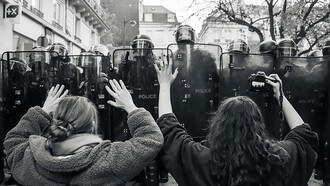Conspiracy theories have always been around, from the Salem witch trials to the moon landing to theories about the COVID pandemic. Most conspiracy theories are harmless, with people spreading stories and beliefs with each other. However, it has been shown in recent events that they can have violent and dangerous consequences. The Capitol insurrection in 2021 shows to what extent a conspiracy can lead to risky actions and a threat to democracy. The FBI cited conspiracy theories as a new domestic terror threat in 2019. In general, social media has facilitated the spread of information, with news being shared instantly. However, has this led to an increase in conspiracy theories and, more importantly, the violent actions that can occur as a result of this?
Globally, there are just over five billion people, equal to 63.7% of the population, that are on social media. Some of the most popular social media platforms are Facebook, YouTube, Instagram, X, and TikTok, with each of them having over a billion users. This shows how many people have access to information and share it on social media, with 50% of adults in 24 out of the 40 measured countries using social media as a news source. A new study by MIT scholars has revealed that false news travels faster than true stories. This shows to what extent social media can reach and influence users.
A prominent example is the outbreak of the COVID-19 pandemic and the rise to many conspiracy theories. Many social media users consumed and spread misinformation through social media, with many rumours about the vaccine, origin, and reality of the virus. Millions of people interacted and debated online, resulting in real-life consequences, where increases in conspiracy beliefs were associated with people decreasing their mask use and a decreased intention of getting vaccinated. In addition, thousands of people protested measures taken by the government in response to the virus. Many of these protests turned violent, with examples of both Belgian and Dutch police being attacked by protesters with fireworks, rocks, and fires.
Similarly, online speculation with dangerous consequences occurred surrounding the Idaho murders in 2022. Following the tragic death of four students from the University of Idaho, for which the suspect has now been arrested and charged, many conspiracies circulated on social media. Primarily on TikTok, the speculations were widespread in the months before the arrest by law enforcement. TikTok users publicly named individuals involved in the case, releasing personal information, although the police had already ruled them out as suspects. The online witch hunt resulting in harassment led an associate professor at the University of Idaho to file a lawsuit against the user who accused her of planning the attack. The police were also forced to publicly deny the theory of the involvement of the professor in the case. This shows the dangerous consequences of thousands of users circulating theories online. In addition, the theories are widespread and reach across countries at a rate they have not been able to before.
However, the question arises if conspiracy theories have increased solely due to social media, as they have always been talked about. Through history, there have been many conspiracy theories, with many flourishing across America in the 1800s. There were the witch trials in Salem and newspapers spreading stories about European elites controlling democracy. Some of the theories can be recognised in current conspiracies that we witness on social media.
This shows that conspiracies have been present in society for a long time. However, multiple studies indicate that there are associations between social media use and the belief in conspiracy theories and misinformation. As more people regularly get their news from social media, research suggests that it increases the belief in conspiracy theories. Specifically, people that use Facebook and YouTube tend to have a higher trust in the theories. Nevertheless, this only applies in the case of low to moderate critical thinking. Social media has facilitated the spread of information, which means that individuals that tend to believe in conspiracy theories can access more evidence and reach many other people, but it does not necessarily mean that everyone with regular social media use believes in conspiracies.
Regardless, the Capitol insurrection shows the modern problem of conspiracists connecting and taking action for their beliefs. Governments and social media companies should regard it as a real threat, as recent events have shown the violence that can occur. Media literacy should be encouraged and implemented to combat the spread of misinformation.
Notes
1 Monmouth University. (n.d.). Conspiracy theories.
2 Statista. (2024). Digital population worldwide as of July 2024.
3 Statista. (n.d.). Social media news consumption worldwide.
4 Friggeri, A., B. Adamic, L. A., Eckles, D., & Goffman, A. (2018). Study: false news travels faster than true stories on Twitter. MIT News.
5 BBC News. (2022, February 15). Protests erupt across Europe over COVID measures.















